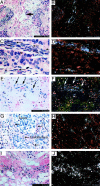Gene expression profiling in an in vitro model of angiogenesis
- PMID: 10854212
- PMCID: PMC1850089
- DOI: 10.1016/S0002-9440(10)65062-6
Gene expression profiling in an in vitro model of angiogenesis
Abstract
In the present study we have used a novel, comprehensive mRNA profiling technique (GeneCalling) for determining differential gene expression profiles of human endothelial cells undergoing differentiation into tubelike structures. One hundred fifteen cDNA fragments were identified and shown to represent 90 distinct genes. Although some of the genes identified have previously been implicated in angiogenesis, potential roles for many new genes, including OX-40, white protein homolog, KIAA0188, a homolog of angiopoietin-2, ADAMTS-4 (aggrecanase-1), and stanniocalcin were revealed. Support for the biological significance was confirmed by the abrogation of the changes in the expression of angiogenesis inhibitors and in situ hybridization studies. This study has significantly extends the molecular fingerprint of the changes in gene expression that occur during endothelial differentiation and provides new insights into the potential role of a number of new molecules in angiogenesis.
Figures


Similar articles
-
In silico data filtering to identify new angiogenesis targets from a large in vitro gene profiling data set.Physiol Genomics. 2002 Jul 12;10(1):13-20. doi: 10.1152/physiolgenomics.00035.2002. Physiol Genomics. 2002. PMID: 12118101
-
[Gene expression profiling of microvascular endothelial cells during capillary morphogenesis in an in vitro model of angiogenesis].Zhonghua Wai Ke Za Zhi. 2005 Jan 1;43(1):37-41. Zhonghua Wai Ke Za Zhi. 2005. PMID: 15774172 Chinese.
-
The homeobox gene Gax inhibits angiogenesis through inhibition of nuclear factor-kappaB-dependent endothelial cell gene expression.Cancer Res. 2005 Feb 15;65(4):1414-24. doi: 10.1158/0008-5472.CAN-04-3431. Cancer Res. 2005. PMID: 15735029
-
Role of the vascular endothelial growth factor isoforms in retinal angiogenesis and DiGeorge syndrome.Verh K Acad Geneeskd Belg. 2005;67(4):229-76. Verh K Acad Geneeskd Belg. 2005. PMID: 16334858 Review.
-
[Role of the ETS transcription factors in the control of endothelial-specific gene expression and in angiogenesis].Bull Cancer. 2001 Feb;88(2):137-42. Bull Cancer. 2001. PMID: 11257588 Review. French.
Cited by
-
Silica-based branched hollow microfibers as a biomimetic extracellular matrix for promoting tumor cell growth in vitro and in vivo.Adv Mater. 2013 May 7;25(17):2492-6. doi: 10.1002/adma.201204472. Epub 2013 Mar 1. Adv Mater. 2013. PMID: 23450784 Free PMC article.
-
ADAMTS proteinases: a multi-domain, multi-functional family with roles in extracellular matrix turnover and arthritis.Arthritis Res Ther. 2005;7(4):160-9. doi: 10.1186/ar1783. Epub 2005 Jun 21. Arthritis Res Ther. 2005. PMID: 15987500 Free PMC article. Review.
-
Expression, function and clinical application of stanniocalcin-1 in cancer.J Cell Mol Med. 2020 Jul;24(14):7686-7696. doi: 10.1111/jcmm.15348. Epub 2020 May 29. J Cell Mol Med. 2020. PMID: 32468698 Free PMC article. Review.
-
The stress-activated protein kinase pathway and the expression of stanniocalcin-1 are regulated by miR-146b-5p in papillary thyroid carcinogenesis.Cancer Biol Ther. 2020 May 3;21(5):412-423. doi: 10.1080/15384047.2020.1721250. Epub 2020 Feb 9. Cancer Biol Ther. 2020. PMID: 32037949 Free PMC article.
-
Research progress of STC2 in breast cancer.Biophys Rep. 2021 Jun 30;7(3):185-192. doi: 10.52601/bpr.2021.210002. Biophys Rep. 2021. PMID: 37287492 Free PMC article.
References
-
- Shimkets RA, Lowe DG, Tai JT, Sehl P, Jin H, Yang R, Predki PF, Rothberg BE, Murtha MT, Roth ME, Shenoy SG, Windemuth A, Simpson JW, Simons JF, Daley MP, Gold SA, McKenna MP, Hillan K, Went GT, Rothberg JM: Gene expression analysis by transcript profiling coupled to a gene database query. Nat Biotechnol 1999, 17:798-803 - PubMed
-
- Lu L, Gillett N: An optimized protocol for in situ hybridization using PCR generated 33P-labeled riboprobes. Cell Vision 1994, 1:169-176
-
- Xin X, Yang S, Kowalski J, Gerritsen ME: Peroxisome proliferator-activated receptor gamma ligands are potent inhibitors of angiogenesis in vitro and in vivo. J Biol Chem 1999, 274:9116-9121 - PubMed
-
- Maisonpierre PC, Suri C, Jones PF, Bartunkova S, Wiegand SJ, Radziejewski C, Compton D, McClain J, Aldrich TH, Papadopoulos N, Daly TJ, Davis S, Sato TN, Yancopoulos GD: Angiopoietin-2, a natural antagonist for Tie2 that disrupts in vivo angiogenesis. Science 1997, 277:55-60 - PubMed
MeSH terms
Substances
LinkOut - more resources
Full Text Sources
Other Literature Sources

